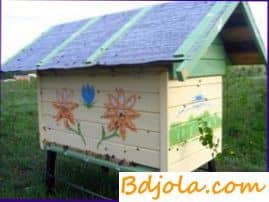
It has long been known that if a bean for feeding bees is placed behind a plaque at the bottom of a beehive or under a roof on a frame, the bees will glue it with propolis. There is nothing surprising. All the cracks, cracks inside the nest of the bee, are covered with propolis – a natural bactericidal substance.
I decided to conduct such an experience. He made two new, open-topped wooden troughs with tents and put the family under the roof on a clean ceiling in parallel with the slit.
The distance between the feeders was 20 mm. The gap between the ceiling was extended by 10 mm along the entire length. The experiment was conducted in August and early September.
Every evening and even during the day for ten days in a trough poured sugar syrup, the other was empty. In this way, I gave the bees the opportunity to glaze the propolis with a crevice formed between the bottom of the trough and the ceiling. At the same time he proceeded from the consideration that for instinct there should be no difference what kind of gap to cover with propolis. The gap is a gap. However, the bee with the beet syrup was glued to propolis with propolis, but empty was not. I want to note that during the ten days the bees also visited an empty feeder, they examined it both inside and outside. But here to cover with a propolis a crack, as they did with a trough with sugar syrup, for some reason did not wish. Apparently, bees worry only about their food?
Some beekeepers suggest in the summer to increase the sub-frame space to 32 mm for the convenience of ventilation. I liked this proposal. I made two beehives with a height of 28 mm under the frame space. But the bees immediately corrected my mistake. They at the bottom built a lot of pyramids, so that they could climb to the honeycomb easier and faster. Now I believe that the approximate height of the sub-frame space should be the same as from the top of the pyramids to the lower slats of the frames.
Pyramids bees build only during the hot season, when every minute is expensive. But in the bee family, work for all individuals has already been determined, so who is doing this?
I want to note that at a height of the podramochnogo space of 40 or 50 mm no pyramid bees are built. I think that such high constructions do not have enough building material. But at a height of 25 or 28 mm, when the difference between the length of the bee and the height is small, the bees substitute themselves “pyramid stools”. Well, is not it a mystery for permission?
Метод чайкина. Выкачка меда когда.
Beer lover's section